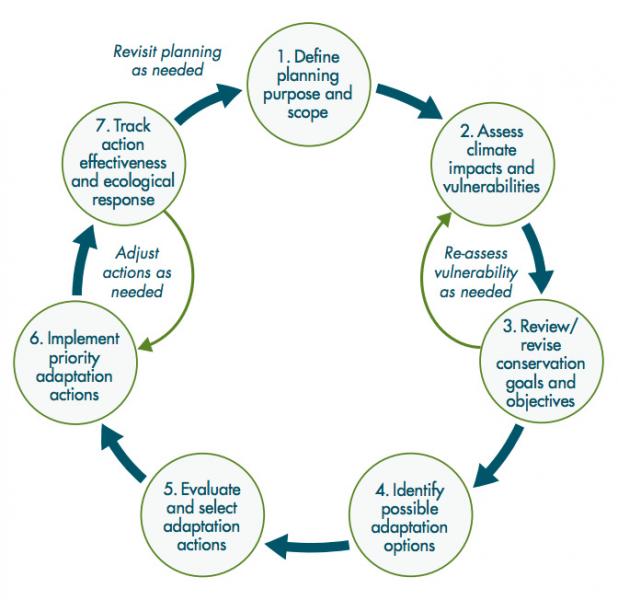Assessment and Planning
Tribal Nations in every region of the United States have begun building adaptive capacity and resilience to climate change impacts. Proactively preparing for climate change can reduce impacts, vulnerabilities, and costs over time, while also facilitating a more rapid and efficient response to changes. Adaptation (to address and prepare for impacts) and mitigation (to reduce future climate change) are both becoming more widespread, but current implementation efforts are insufficient to avoid increasingly negative social, environmental, and economic consequences. Integrating scientific information with traditional knowledges (TKs) provides the greatest opportunities to adapt to the changes already being felt. For more information on TKs, see the Tribal Nations topic discussion and the Guidelines for Considering Traditional Knowledges in Climate Change Initiatives tool.
Adaptation to multiple stressors requires assessment of the composite threats, as well as making tradeoffs among costs, benefits, and risks of available options. Vulnerability to climate change is exacerbated by other stresses such as pollution, habitat fragmentation, and poverty. Indigenous communities across the United States are experiencing infrastructure losses, unpredictable water availability, and increased frequency and intensity of extreme events. Even though these communities are experiencing increasing awareness of climate change and interest in comprehensive adaptation planning, lack of funding, human resources, access to information, training, and expertise provide significant barriers.
Uncertainties in the scale and location of climate impacts can make decision making difficult. Response strategies—especially those that try to anticipate possible unintended consequences—can be more effective with early planning. Climate change projections have inherent uncertainties, although the climate models are becoming increasingly more accurate with new data. It is important to develop, refine, and deploy tools and integrated approaches that enable iterative decision making and increase the flexibility and robustness of climate change responses.
The preceding text was excerpted and adapted from the report Climate Change Impacts in the United States: The Third National Climate Assessment (Chapter 12: Indigenous Peoples, Lands, and Resources).
How should we prepare for and respond to the impacts of climate change? Tribal planners and resource managers will need to adopt forward-looking goals and implement strategies specifically designed to prepare for and adjust to current and future climatic changes. Many guidebooks and resources are available that provide frameworks and tools for the assessment and adaptation planning process. Preparing for Climate Change: A Guidebook for Local, Regional, and State Governments, by the Climate Impacts Group, ICLEI, and King County, WA, and Being Prepared for Climate Change: A Workbook for Developing Risk-Based Adaptation Plans, by the U.S. Environmental Protection Agency, provide frameworks for developing high-level, risk-based strategic adaptation plans. Other guidebooks, such as Climate-Smart Conservation (discussed below), introduces adaptation planning and links to case studies, tools, information, and expertise that planners and resource managers can use for informed decision making. Consider reviewing different guidebooks before embarking on a climate change planning initiative with your community; there are similarities and differences, and you may find a guidebook that is a good fit for your planning project.
Featured Tool
Climate-Smart Conservation: Putting Adaptation Principles into Practice is intended to demystify adaptation. The planning cycle at right demonstrates how the various parts of the process fit together. Although the cycle mirrors many existing conservation planning and adaptive management approaches, it is designed specifically to support climate adaptation, especially through assessment of climate-related vulnerabilities (step 2), and a re-evaluation of conservation goals in light of those vulnerabilities (step 3). Each conservation challenge is unique to each locale and situation, thus a one-size-fits-all solution to climate impacts does not exist. Instead, each tribe will thoughtfully craft adaptation strategies that take into account likely climate shifts and impacts, the specifics of the ecological and tribal resources, existing stresses and threats, and opportunities for meaningful action.
The preceding text was excerpted and adapted from Climate-Smart Conservation: Putting Adaptation Principles into Practice, Executive Summary.
You can also learn from climate change adaptation plans that have been developed by tribes, states and local governments. Case studies of adaptation planning and implementation are available on this website and on the Tribes & Climate Change website, which also includes a resource database, an events calendar, and the Tribal Climate Change Adaptation Planning Toolkit. The Bureau of Indian Affairs (BIA) and many other federal agencies and inter-tribal groups are adapting climate change programs, tools, and resources and expand funding opportunities to better address the needs of Tribal Nations. For an inventory of these expanding resources, visit the BIA Climate Change website.

